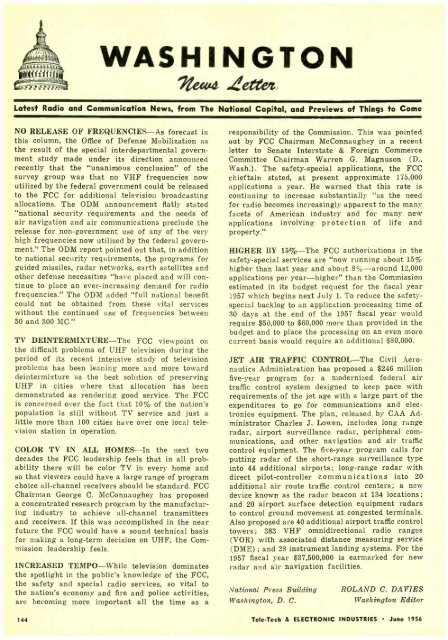TELE-TECH & - AmericanRadioHistory.Com
TELE-TECH & - AmericanRadioHistory.Com
TELE-TECH & - AmericanRadioHistory.Com
You also want an ePaper? Increase the reach of your titles
YUMPU automatically turns print PDFs into web optimized ePapers that Google loves.
WASHINGTON<br />
eetem<br />
Latest Radio and <strong>Com</strong>munication News, from The National Capital, and Previews of Things to <strong>Com</strong>e<br />
NO RELEASE OF FREQUENCIES -As forecast in<br />
this column, the Office of Defense Mobilization as<br />
the result of the special interdepartmental government<br />
study made under its direction announced<br />
recently that the "unanimous conclusion" of the<br />
survey group was that no VHF frequencies now<br />
utilized by the federal government could be released<br />
to the FCC for additional television broadcasting<br />
allocations. The ODM announcement flatly stated<br />
"national security requirements and the needs of<br />
air navigation and air communications preclude the<br />
release for non -government use of any of the very<br />
high frequencies now utilized by the federal government."<br />
The ODM report pointed out that, in addition<br />
to national security requirements, the programs for<br />
guided missiles, radar networks, earth satellites and<br />
other defense necessities "have placed and will continue<br />
to place an ever -increasing demand for radio<br />
frequencies." The ODM added "full national benefit<br />
could not be obtained from these vital services<br />
without the continued use of frequencies between<br />
50 and 300 MC."<br />
TV DEINTERMIXTURE -The FCC viewpoint on<br />
the difficult problems of UHF television during the<br />
period of its recent intensive study of television<br />
problems has been leaning more and more toward<br />
deintermixture as the best solution of preserving<br />
UHF in cities where that allocation has been<br />
demonstrated as rendering good service. The FCC<br />
is concerned over the fact that 10% of the nation's<br />
population is still without TV service and just a<br />
little more than 100 cities have over one local television<br />
station in operation.<br />
COLOR TV IN ALL HOMES -In the next two<br />
decades the FCC leadership feels that in all probability<br />
there will be color TV in every home and<br />
so that viewers could have a large range of program<br />
choice all- channel receivers should be standard. FCC<br />
Chairman George C. McConnaughey has proposed<br />
a concentrated research program by the manufacturing<br />
industry to achieve all- channel transmitters<br />
and receivers. If this was accomplished in the near<br />
future the FCC would have a sound technical basis<br />
for making a long -term decision on UHF, the <strong>Com</strong>mission<br />
leadership feels.<br />
INCREASED TEMPO -While television dominates<br />
the spotlight in the public's knowledge of the FCC,<br />
the safety and special radio services, so vital to<br />
the nation's economy and fire and police activities,<br />
are becoming more important all the time as a<br />
responsibility of the <strong>Com</strong>mission. This was pointed<br />
out by FCC Chairman McConnaughey in a recent<br />
letter to Senate Interstate & Foreign <strong>Com</strong>merce<br />
<strong>Com</strong>mittee Chairman Warren G. Magnuson (D.,<br />
Wash.). The safety- special applications, the FCC<br />
chieftain stated, at present approximate 175,000<br />
applications a year. He warned that this rate is<br />
continuing to increase substantially "as the need<br />
for radio becomes increasingly apparent to the many<br />
facets of American industry and for many new<br />
applications involving protection of life and<br />
property."<br />
HIGHER BY 15% -The FCC authorizations in the<br />
safety -special services are "now running about 15%<br />
higher than last year and about 8%-around 12,000<br />
applications per year- higher" than the <strong>Com</strong>mission<br />
estimated in its budget request for the fiscal year<br />
1957 which begins next July 1. To reduce the safety -<br />
special backlog to an application processing time of<br />
30 days at the end of the 1957 fiscal year would<br />
require $50,000 to $60,000 more than provided in the<br />
budget and to place the processing on an even more<br />
current basis would require an additional $80,000.<br />
JET AIR TRAFFIC CONTROL -The Civil Aeronautics<br />
Administration has proposed a $246 million<br />
five -year program for a modernized federal air<br />
traffic control system designed to keep pace with<br />
requirements of the jet age with a large part of the<br />
expenditures to go for communications and electronics<br />
equipment. The plan, released by CAA Administrator<br />
Charles J. Lowen, includes long range<br />
radar, airport surveillance radar, peripheral communications,<br />
and other navigation and air traffic<br />
control equipment. The five -year program calls for<br />
putting radar of the short -range surveillance type<br />
into 44 additional airports; long -range radar with<br />
direct pilot -controller communications into 20<br />
additional air route traffic control centers; a new<br />
device known as the radar beacon at 134 locations;<br />
and 20 airport surface detection equipment radars<br />
to control ground movement at congested terminals.<br />
Also proposed are 40 additional airport traffic control<br />
towers; 383 VHF omnidirectional radio ranges<br />
(VOR) with associated distance measuring service<br />
(DME) ; and 28 instrument landing systems. For the<br />
1957 fiscal year $37,500,000 is earmarked for new<br />
radar and air navigation facilities.<br />
National Press Building<br />
Washington, D. C.<br />
ROLAND C. DAVIES<br />
Washington Editor<br />
144 Tele -Tech & ELECTRONIC INDUSTRIES June 1956
















